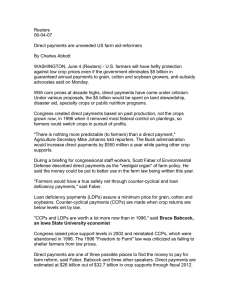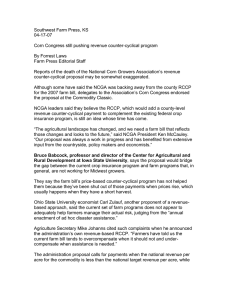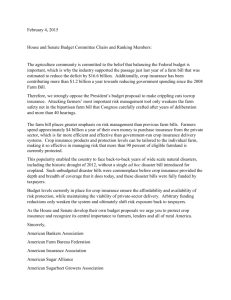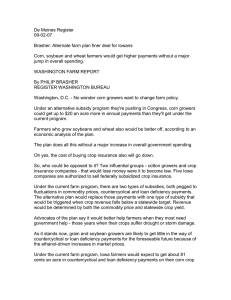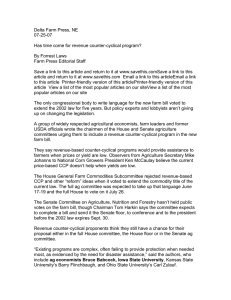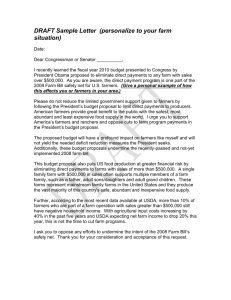Delta Farm Press, NE 09-12-07 Revised revenue program draws mixed reviews
advertisement
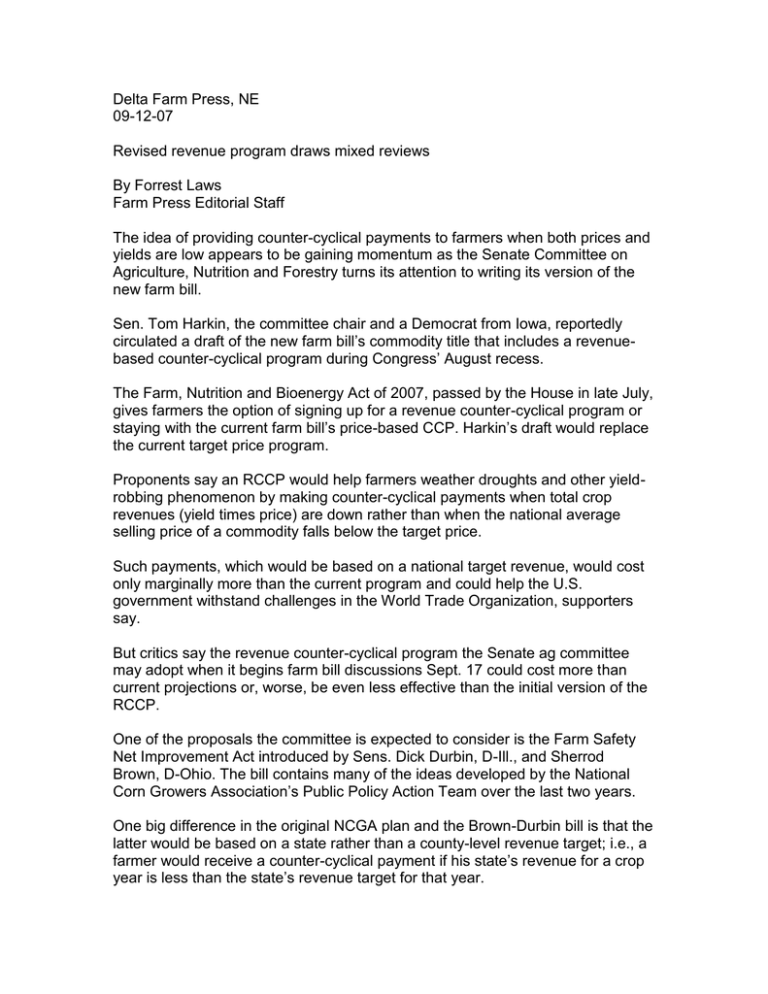
Delta Farm Press, NE 09-12-07 Revised revenue program draws mixed reviews By Forrest Laws Farm Press Editorial Staff The idea of providing counter-cyclical payments to farmers when both prices and yields are low appears to be gaining momentum as the Senate Committee on Agriculture, Nutrition and Forestry turns its attention to writing its version of the new farm bill. Sen. Tom Harkin, the committee chair and a Democrat from Iowa, reportedly circulated a draft of the new farm bill’s commodity title that includes a revenuebased counter-cyclical program during Congress’ August recess. The Farm, Nutrition and Bioenergy Act of 2007, passed by the House in late July, gives farmers the option of signing up for a revenue counter-cyclical program or staying with the current farm bill’s price-based CCP. Harkin’s draft would replace the current target price program. Proponents say an RCCP would help farmers weather droughts and other yieldrobbing phenomenon by making counter-cyclical payments when total crop revenues (yield times price) are down rather than when the national average selling price of a commodity falls below the target price. Such payments, which would be based on a national target revenue, would cost only marginally more than the current program and could help the U.S. government withstand challenges in the World Trade Organization, supporters say. But critics say the revenue counter-cyclical program the Senate ag committee may adopt when it begins farm bill discussions Sept. 17 could cost more than current projections or, worse, be even less effective than the initial version of the RCCP. One of the proposals the committee is expected to consider is the Farm Safety Net Improvement Act introduced by Sens. Dick Durbin, D-Ill., and Sherrod Brown, D-Ohio. The bill contains many of the ideas developed by the National Corn Growers Association’s Public Policy Action Team over the last two years. One big difference in the original NCGA plan and the Brown-Durbin bill is that the latter would be based on a state rather than a county-level revenue target; i.e., a farmer would receive a counter-cyclical payment if his state’s revenue for a crop year is less than the state’s revenue target for that year. According to Carl Zulauf, professor of agricultural economics at Ohio State University, the state revenue target under Brown-Durbin would equal the state’s expected yield times the revenue counter-cyclical pre-planting price times 90 percent. Some definitions: The state expected yield is the state’s “trend” yield per planted acre for the 1980-2006 crops; the revenue pre-planting price is the average of the current and past two years’ Federal Crop Insurance pre-planting price. USDA would calculate the actual state revenue, which would equal the state yield per planted acre times the revenue counter-cyclical harvest price or the harvest price Federal Crop Insurance uses for its revenue assurance products. A farmer’s counter-cyclical revenue payment would equal the state revenue target minus the state actual revenue times the farmer’s planted acres times the farmer’s actual production history divided by the state expected yield times 90 percent, according to Zulauf. While it may take farmers a while to get their arms around all those terms, one thing growers should know is that a state revenue target-based program could be less effective than a county-revenue program. It would also be less expensive, a major consideration given the lower baseline for commodity programs in the 2007 farm bill. It would cost substantially more than the national target revenue-based program Agriculture Secretary Mike Johanns has been pushing but, again, would also be more effective according to some observers. Sen. Kent Conrad, D-N.D., an ag committee member and chairman of the Senate Budget Committee, says a revenue CCP, based on a national per-acre income, would not work in states like North Dakota. “The reason that doesn’t work for us is we have great yield variation,” Conrad told farmers attending a farm forum he held with House Agriculture Committee Chairman Collin Peterson. “You would have people out here who would have massive yield losses and no payments.” Unlike states such as Illinois, Indiana and Iowa (where the RCCP concept was developed), Conrad’s state and the Sun Belt states have more variable weather and thus less stable yields, he said. (Conrad was a major supporter of disaster legislation because North Dakota farmers suffered droughts, floods, freezes and diseases over a two-year period.) An RCCP with a national revenue target could mean southern producers would be dependent on weather conditions in other regions. The South could be hit with drought, for example, but if growing conditions were better in the Midwest, southern corn and soybean producers would be unlikely to receive a payment. Conrad said that, ideally, a revenue counter-cyclical program should be based on county-level target revenues to make sure that the payments go to producers who experience low revenues. Otherwise, farmers will continue to complain that payments are not, well, targeted at growers who need them. But Congressional Budget Office projections show a county-revenue program would cost $5 billion to $6 billion more than the national-revenue CCP contained in the House-passed farm bill. Some analysts say an RCCP could also mean the end of federal crop insurance revenue assurance programs that have become increasingly popular as risk management tools in the Midwest states. The Brown-Durbin bill says USDA’s Risk Management and Farm Service Agencies would be required to work together to “ensure that producers are not compensated by the revenue counter-cyclical program and Federal Crop Insurance for the same loss,” says Zulauf. “The latter should reduce insurance premiums paid by farmers.” If farmers can’t collect on federal crop insurance, then why buy it? “The Corn Growers’ farm-level analysis infers that the new programs would result in the end of the crop insurance program,” says Timothy J. Galvin, former administrator of USDA’s Foreign Agricultural Service and a congressional staffer for 20 years. “Should that be the case, then a major risk-management tool, tailored to a producer’s specific farming operation, would be lost, only to be replaced in part by a program (RCCP) under which payouts are based on county revenue rather than farm revenue.” Because natural disasters often occur unevenly even in a given county, a countybased trigger may result, on the one hand, in payments to producers who experienced no loss, while, on the other, providing no payments to producers who experienced losses within a county that generally fared well. “By contrast, current crop insurance policies — tailored to actual production on a farm — are tools that farmers literally can take to the bank when securing credit and can serve as the foundation for a marketing plan.” Economists such as Bruce Babcock, director of the Center for Agricultural and Rural Development at Iowa State University, say some farmers would applaud the demise of the current Federal Crop Insurance programs. “No one really likes the crop insurance programs,” said Babcock. “They think it doesn’t provide enough coverage, the premiums are too high for the coverage or they don’t like that when multiple-year losses occur, the coverage goes down.” (Babcock supports RCCP-type programs, which he sees as a much-improved version of crop insurance.) Others say the cost projections for the RCCP — the National Corn Growers said early on the program would cost only $500 million above the CBO baseline — are misleading. “What is left out is that the RCCP would not kick in until the third year of the next farm bill under that scenario,” said the executive director of one southern farm organization. “There would be no coverage for the first two years.” Proponents say it will take USDA two years to write the regulations and prepare the data needed for the calculations to figure the payments. USDA and CBO projections, meanwhile, show cotton farmers are the only ones likely to receive CCP payments for those years. Critics also say the RCCP might not be the panacea for challenges to the U.S. farm program in the world trade arena. The National Corn Growers Association has said it believes RCCP payments would be assigned to the World Trade Organization’s “Green Box” category that allows unlimited payments. Galvin disagrees. “As proposed, the revenue counter-cyclical program would seem to fail at least three of the conditions specified in the Uruguay Round Agreement on Agriculture because the proposed payments are directly related to the “type” (corn), “volume of production” (farm-level yield), and “prices” (national market price) of the commodity. “In addition, the program’s use of regional, variable costs of production in arriving at net income may be construed as relating to the “factors of production employed.” Another problem may be that payment received in prior years from loan deficiency and counter-cyclical payment programs will be counted as net revenue in the years prior to implementation. “However, the Uruguay Round Agreement is quite clear that ‘any payments from government income insurance or income safety-net programs or similar schemes’ must be excluded in determining gross or net income in previous years for purposes of making payments under a green box revenue insurance program,” says Galvin. Farmers know one 1987-style drought in the Midwest or a $30- to $40-per-barrel drop in the price of oil could change that, which is why farm group leaders such as NCGA President Ken McCauley are pushing for inclusion of the revenue counter-cyclical program in the new farm bill. “The demand for corn is strong and shows every sign of being that way for a while,” he said. “But we know that may not always be the case.”
